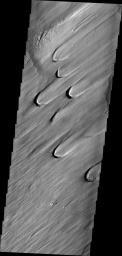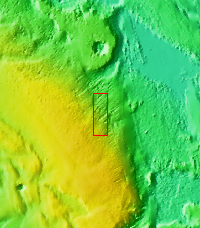
|
Wind Texture
- Click the image above for a larger view
- Full-Res JPEG (1325 x 2774) (560.4 kB)
- Full-Res TIFF (1325 x 2774) (3.7 MB)
Caption:
On Earth, these wind-derived features are called 'blowouts,' where the force of the wind has carved out a crescent-shaped depression in soft, uncemented material like glacial loess. The features on Mars are much larger than the ones on Earth.
Orbit Number: 40403 Latitude: -0.932672 Longitude: 204.318 Instrument: VIS Captured: 2011-01-23 01:15
Background Info:
Please see the THEMIS Data Citation Note for details on crediting THEMIS images.
NASA's Jet Propulsion Laboratory manages the 2001 Mars Odyssey mission for NASA's Science Mission Directorate, Washington, D.C. The Thermal Emission Imaging System (THEMIS) was developed by Arizona State University, Tempe, in collaboration with Raytheon Santa Barbara Remote Sensing. The THEMIS investigation is led by Dr. Philip Christensen at Arizona State University. Lockheed Martin Astronautics, Denver, is the prime contractor for the Odyssey project, and developed and built the orbiter. Mission operations are conducted jointly from Lockheed Martin and from JPL, a division of the California Institute of Technology in Pasadena.
Cataloging Keywords:
| Name | Value | Additional Values |
|---|---|---|
| Target | Mars | |
| System | ||
| Target Type | Planet | |
| Mission | 2001 Mars Odyssey | |
| Instrument Host | Mars Odyssey | |
| Host Type | Orbiter | |
| Instrument | Thermal Emission Imaging System (THEMIS) | |
| Detector | ||
| Extra Keywords | Grayscale, Thermal | |
| Acquisition Date | ||
| Release Date | 2011-03-23 | |
| Date in Caption | 2011-01-23 | |
| Image Credit | NASA/JPL/ASU | |
| Source | photojournal.jpl.nasa.gov/catalog/PIA13941 | |
| Identifier | PIA13941 | |

